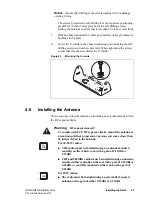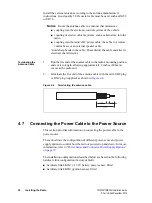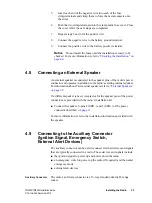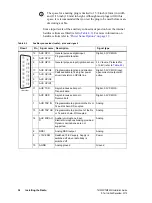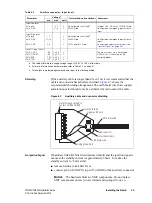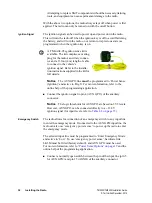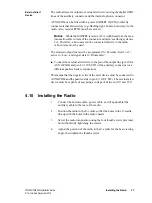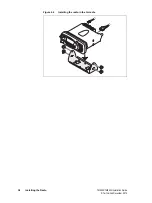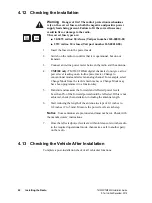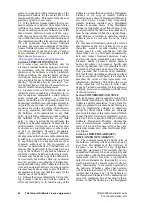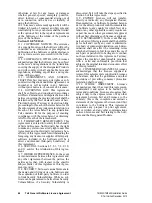
TM9300/TM9400 Installation Guide
Tait General Software Licence Agreement
41
© Tait Limited
December 2015
Tait General Software Licence Agreement
This Software License Agreement ("Agree-
ment") is between you (“Licensee”) and Tait
Limited (“Tait").
By using any of the Software items embedded
and pre-loaded in the related Tait Designated
Product, included on CD, downloaded from the
Tait website, or provided in any other form, you
agree to be bound by the terms of this Agree-
ment. If you do not agree to the terms of this
Agreement, do not install or use any of the Soft-
ware. If you install or use any of the Software,
that will be deemed to be acceptance of the
terms of this Agreement.
For good and valuable consideration, the parties
agree as follows:
Section 1 DEFINITIONS
“Confidential Information”
means all or any
information supplied to or received by Licensee
from Tait, whether before or after installation or
use and whether directly or indirectly pertaining
to the Software and Documentation supplied by
Tait, including without limitation all informa-
tion relating to the Designated Products, har-
dware, software; copyright, design registra-
tions, trademarks; operations, processes, and
related business affairs of Tait; and including
any other goods or property supplied by Tait to
Licensee pursuant to the terms of this Agree-
ment.
“Designated Products”
means products pro-
vided by Tait to Licensee with which or for
which the Software and Documentation is
licensed for use.
“Documentation”
means product and sof-
tware documentation that specifies technical
and performance features and capabilities; user,
operation, and training manuals for the Soft-
ware; and all physical or electronic media upon
which such information is provided.
“Executable Code”
means Software in a form
that can be run in a computer and typically
refers to machine language, which is comprised
of native instructions the computer carries out in
hardware. Executable code may also refer to
programs written in interpreted languages that
require additional software to actually execute.
“Intellectual Property Rights”
and
“Intel-
lectual Property”
mean the following or their
substantial equivalents or counterparts, recog-
nized by or through action before any govern-
mental authority in any jurisdiction throughout
the world and including, but not limited to all
rights in patents, patent applications, inventions,
copyrights, trademarks, trade secrets, trade
names, and other proprietary rights in or relating
to the Software and Documentation; including
any adaptations, corrections, de-compilations,
disassemblies, emulations, enhancements fixes,
modifications, translations and updates to or
derivative works from, the Software or Docu-
mentation, whether made by Tait or another
party, or any improvements that result from Tait
processes or, provision of information services.
“Licensee”
means any individual or entity that
has accepted the terms of this License.
“Open Source Software”
means software
with freely obtainable source code and license
for modification, or permission for free distribu-
tion.
“Open Source Software License”
means the
terms or conditions under which the Open
Source Software is licensed.
“Person”
means any individual, partnership,
corporation, association, joint stock company,
trust, joint venture, limited liability company,
governmental authority, sole proprietorship, or
other form of legal entity recognized by a gov-
ernmental authority.
“Security Vulnerability”
means any flaw or
weakness in system security procedures, design,
implementation, or internal controls that if exer-
cised (accidentally triggered or intentionally
exploited) could result in a security breach such
that data is compromised, manipulated, or sto-
len, or a system is damaged.
“Software”
(i) means proprietary software in
executable code format, and adaptations, trans-
lations, de-compilations, disassemblies, emula-
tions, or derivative works of such software; (ii)
means any modifications, enhancements, new
versions and new releases of the software pro-
vided by Tait; and (iii) may contain one or more
items of software owned by a third-party sup-
plier. The term "Software" does not include any
third-party software provided under separate
license or not licensable under the terms of this
Agreement.
“Source Code”
means software expressed in
human readable language necessary for under-
standing, maintaining, modifying, correcting,
and enhancing any software referred to in this
Agreement and includes all states of that sof-
tware prior to its compilation into an executable
programme.
“Tait”
means Tait Limited and includes its
Affiliates.
Section 2 SCOPE
This Agreement contains the terms and condi-
tions of the license Tait is providing to Licensee,
and of Licensee’s use of the Software and Doc-
umentation. Tait and Licensee enter into this
Agreement in connection with Tait delivery of
certain proprietary Software and/or products
containing embedded or pre-loaded proprietary
Software.
Section 3 GRANT OF LICENSE
3.1. Subject to the provisions of this Agreement
and the payment of applicable license fees, Tait
grants to Licensee a personal, limited, non-
transferable (except as permitted in Section 7),
and non-exclusive license to use the Software in
executable code form, and the Documentation,



